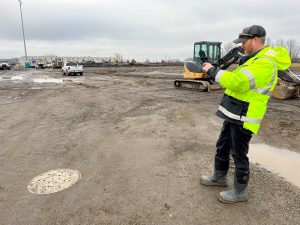Our Stormwater Super-Team: How the Port of Vancouver USA Helps Safeguard Southwest Washington’s Waterways

Port Environmental Specialist, Mark Tauscher, inspects a job site for stormwater management after recent rain.
Northwesterners are no stranger to rain. In fact, we are so accustomed to “liquid sunshine” that when we see someone with an umbrella, we automatically assume they are from out of town. But the term stormwater may be less familiar, at least in the environmental protection sense. Stormwater is water produced by rain that, as it runs over surfaces, can pick up pollutants and can get into streams, lakes, and rivers.
For instance, construction sites often involve the disruption of dirt, and therefore can be a risk for stormwater runoff. The potential for soil to leave a construction area via this runoff means that the Port of Vancouver USA must actively manage stormwater from its construction sites to keep our region’s waterways clean. That’s where the port’s CESCL team comes in.
The Port of Vancouver USA has several staff members who are Certified Erosion Sediment Control Leads (CESCL). Certified port employees inspect our current port construction job sites weekly or more often if there have been heavy rainfalls. They are making sure that sediment isn’t leaving the site and verifying that protective measures are installed and working properly.
The Port of Vancouver USA takes stormwater maintenance very seriously. The CESCL team will collect and sample stormwater to measure its clarity to confirm sediment is not leaving the site. But what exactly is our CESCL team looking for? The key measures below are things the CESCL team looks for during inspections to prevent sediment from leaving construction job sites:
- Controlled Pollutants: Remember when your dad would say that “an ounce of prevention is worth a pound of cure”? We do. In other words, we pay a lot of attention to making sure outside pollutants are kept off the ground in the first place. That means we ensure construction equipment is well-maintained and leak-free, and chemicals or fuel are kept in properly sealed containers.
- Marked Clearing Limits: We make sure there’s a clearly marked perimeter around the site. This can be done with fencing, tape, silt fencing to name a few.
- Established Construction Entrance: We use a specialized rock pad – typically, a designated area made with large stones — at the entrance/exit of the site. Pads allow the construction team to shake dirt, rock, and other sediment off a vehicle’s tires prior to it exiting the site.
- Controlled Flow Rate: To control soil, we have a few tools. Sometimes we use specialized plastic mesh tubes filled with natural materials like straw called a straw wattle. We may also use posts and a permeable fabric called a silt fence. These allow water to flow through while keeping sediment in place. Both tools are especially important when the site is on a hill.
- Stabilized Soil: Even without a slope, bare soil can be disturbed by heavy rain and erode, causing large puddles and uneven ground. This can be addressed through strategic placement of gravel, straw, or erosion control blankets.
- Controlled Dewatering: Some construction sites can have areas where a relatively large amount of water can “pond.” To address this, this surface water can be removed through a variety of measures including creating controlled channels and pumping. Our goals is to move the water in a way that keeps sediment onsite.
While construction sites are a big focus, the Port of Vancouver USA works to identify and actively address stormwater wherever it may enter nearby waterways. For instance, we have stormwater management tools like the Grattix which treats water runoff from metal roofs and bio-filtration facilities throughout port property.
Not every project on port property is managed by the port. Many projects are constructed by port tenants and their contractors. The port is committed to regularly inspecting all projects – port-led or not – to ensure construction is meeting or exceeding construction permit guidelines. If any corrective action is needed, the port’s CESCL team works with contractors and port crews to get things back on track.
We believe that environmental stewardship and economic development can co-exist, and we’re committed to doing our part to keep our stormwater clean.
